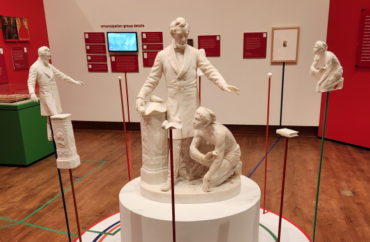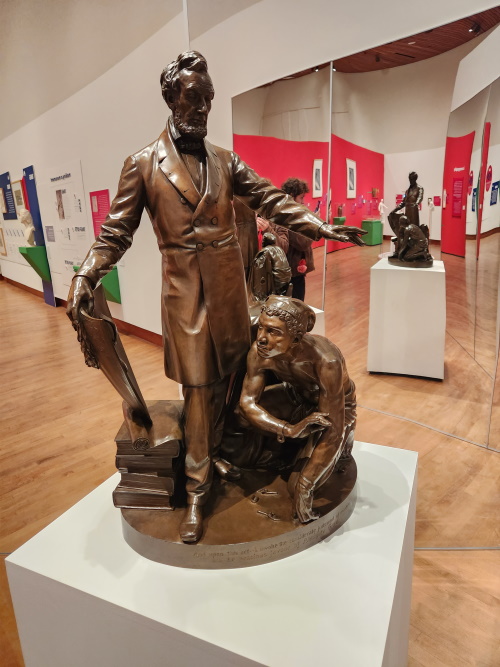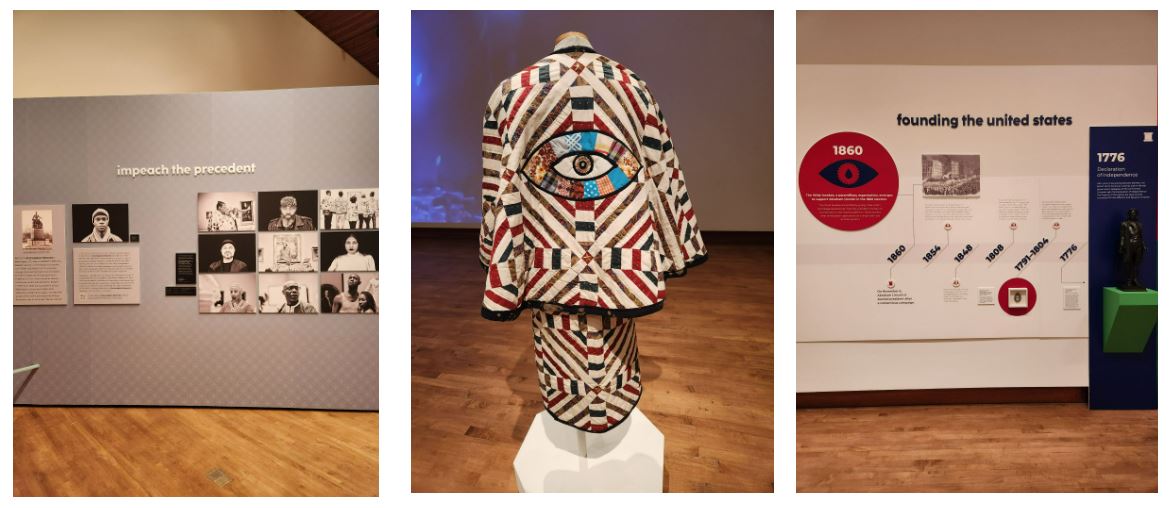
An exhibit in the University of Wisconsin’s Chazen Art Museum presents a critical eye toward the iconography of a historical statue dedicated to President Abraham Lincoln’s Emancipation Proclamation, which freed the slaves.
The UW Madison exhibit, titled “re:mancipation,” examines “Emancipation Group,” a 1873 statue by Thomas Ball, which the museum has displayed openly in its galleries since 1976.
The statue, which shows Abraham Lincoln extending his hand over a kneeling black man with broken shackles on his wrists, has drawn the ire of Chazen museum officials for its “complex history,” and “problematic subject matter,” according to the exhibit’s website.
“Using the sculpture as its central focus, re:mancipation will seek to explore, dissect, and better understand racism in America,” the exhibit’s website states.
A Chazen museum representative did not respond to a request for comment from The College Fix this week.
 Ball’s statue is a controversial one. It was removed from a Boston public square in December 2020 after numerous complaints about “deficiencies in its design,” Boston.gov reported.
Ball’s statue is a controversial one. It was removed from a Boston public square in December 2020 after numerous complaints about “deficiencies in its design,” Boston.gov reported.
“The decision acknowledged the statue’s role in perpetuating harmful prejudices and obscuring the role of Black Americans in shaping the nation’s freedoms. As Frederick Douglass noted in his 1876 letter criticizing the statue, the figure of Alexander, ‘though rising is still on his knees and nude,’” according to the city’s website.
At UW Madison, upon entering the exhibit the viewer is introduced to both the founding of human civilization in Africa and the founding of the United States. As they progress through the exhibit, comparisons are made between African and American art before arriving at the central fixture of Emancipation Group.
In the center of the exhibit, a display dissects Emancipation Group, showing how one’s interpretation of different symbols, known as iconography, shapes their understanding of a piece of art.
“The iconography of the Emancipation Group draws upon many historical references. Understanding the iconography helps us understand both the intended and unintended meanings of the sculpture,” the display states. “Sometimes it is possible to interpret a symbol in multiple ways.”
Throughout the exhibit, references are made to the Wide Awakes, a 1860 group of anti-slavery activists which represented themselves with the symbol of an open eye.
Viewers interact with the Wide Awake movement numerous times throughout the exhibit by drawing their “re:sponses” on pieces of paper printed with open eyes, viewing quilts made to depict the open eye, and a video presentation which highlights the group’s rebirth as a modern social justice activism group.
The video ends by encouraging viewers to be “wide awake” in favor of anti-racism.
In a section called “impeach the precedent,” the exhibit acknowledges comments made by abolitionist Douglass in which he laments the portrayal of the African American man in the statue kneeling “like an animal.”

Cornell University Professor Randy Wayne explained in an email to The College Fix that this quote in context advocates for future improvement on sculptures of Lincoln.
“I hope the historian brings in Frederick Douglass’ speech at the unveiling of the original sculpture and the letter to the editor of the National Republican,” Wayne wrote.
“In the letter to the editor Douglass wrote, ‘What I want to see before I die is a monument representing the negro, not couchant on his knees like a four-footed animal, but erect on his feet like a man. There is room in Lincoln park for another monument, and I throw out this suggestion to the end that it may be taken up and acted upon.’”
Added Wayne: “I hope the new exhibit lives up to Frederick Douglass’ beautiful words and sentiment. Almost more than anyone, Douglass knew how to recognize the past and plan a better future. He is a part of this sculpture’s essence.”
Wayne also noted the erection of the original statue in Washington D.C. was funded by freed slaves.
At the close of UW Madison’s exhibit, the viewer is directed toward a response piece by Sanford Biggers called “Lifting the Veil.” The piece, in dialogue with Ball’s statue, depicts Fredrick Douglass “lifting the veil of ignorance” from a seated Abraham Lincoln.
The museum, however, does not currently have “Lifting the Veil” for display. Museum staff told The College Fix that the timeline for the piece’s arrival is currently unknown.
This is not the first time UW has acted with skepticism toward Lincoln’s legacy.
In 2020, BIPOC students marched on campus’ Bascom Hill to enforce their BIPOC demands, of which removing a prominent statue of Abraham Lincoln was the top action item. Then-Chancellor Rebecca Blank refused to take such an action, but her successor Jennifer Mnookin has since declined to comment on her stance on the campus fixture.
“re:mancipation” currently occupies the same wing of the museum which previously housed “Sifting and Reckoning,” which divulged details about the university’s historical ties to racism.
MORE: University of Wisconsin-Madison debuts exhibit chronicling its racist history
IMAGES: Jackson Walker / For The College Fix
Like The College Fix on Facebook / Follow us on Twitter





Please join the conversation about our stories on Facebook, Twitter, Instagram, Reddit, MeWe, Rumble, Gab, Minds and Gettr.